Evaluation of Legacy Forest Harvesting Impacts on Dominant Stream Water Sources and Implications for Water Quality Using End Member Mixing Analysis
Abstract
1. Introduction
2. Materials and Methods
2.1. Study Site
2.2. Experimental Design
2.3. Field Methods
2.3.1. Flow and Stream Water Chemistry
2.3.2. Groundwater
2.3.3. Soil Water
2.3.4. Throughfall
2.4. Laboratory Methods
2.5. End Member Mixing Analysis Model
2.5.1. Tracer Selection
2.5.2. End Member Mixing Analysis Model
3. Results
3.1. Hydrometeorological Characterization
3.2. Tracer Selection
3.3. End Member and Stream Water Characterization
3.4. EMMA Results
3.4.1. Snowmelt
3.4.2. Summer Storms
3.4.3. Fall
3.4.4. Residuals Analysis
4. Discussion
4.1. Validity of EMMA at TLW
4.2. Insights into Hydrologic Processes
4.3. Wetland Contributions to Stream Flow
4.4. Legacy Harvesting Effects on End Member Contributions to Stream Flow
4.5. Implications for Water Quality and Treatability
5. Conclusions
Supplementary Materials
Author Contributions
Funding
Data Availability Statement
Acknowledgments
Conflicts of Interest
References
- Emelko, M.B.; Silins, U.; Bladon, K.D.; Stone, M. Implications of Land Disturbance on Drinking Water Treatability in a Changing Climate: Demonstrating the Need for “Source Water Supply and Protection” Strategies. Water Res. 2011, 45, 461–472. [Google Scholar] [CrossRef] [PubMed]
- MacDonald, R.; Shemie, D. Urban Water Blueprint; The Nature Conservancy: Washington, DC, USA, 2014. [Google Scholar]
- Stein, S.; Butler, B. On the Front Line: Private Forests & Water Resources; US Department of Agriculture, Forest Service: Washington, DC, USA, 2004; Volume FS-790.
- Stein, S.M.; McRoberts, R.E.; Alig, R.J.; Nelson, M.D.; Theobald, D.M.; Eley, M.; Dechter, M.; Carr, M. Forests on the Edge: Housing Development on America’s Private Forests; US Department of Agriculture, Forest Service, Pacific Northwest Research Station: Washington, DC, USA, 2005.
- Sun, G.; Vose, J.M. Forest Management Challenges for Sustaining Water Resources in the Anthropocene. Forests 2016, 7, 68. [Google Scholar] [CrossRef]
- de Groot, R.; Brander, L.; van der Ploeg, S.; Costanza, R.; Bernard, F.; Braat, L.; Christie, M.; Crossman, N.; Ghermandi, A.; Hein, L.; et al. Global Estimates of the Value of Ecosystems and Their Services in Monetary Units. Ecosyst. Serv. 2012, 1, 50–61. [Google Scholar] [CrossRef]
- Costanza, R.; d’Arge, R.; de Groot, R.; Farber, S.; Grasso, M.; Hannon, B.; Limburg, K.; Naeem, S.; O’Neill, R.V.; Paruelo, J.; et al. The Value of the World’s Ecosystem Services and Natural Capital. Ecol. Econ. 1998, 25, 3–15. [Google Scholar] [CrossRef]
- Caretta, M.A.; Mukherji, A.; Arfanuzzaman, M.; Betts, R.A.; Gelfan, A.; Hirabayashi, Y.; Lissner, T.K.; Liu, J.; Gunn, E.L.; Morgan, R.; et al. Water. In Climate Change 2022: Impacts, Adaptation, and Vulnerability. Contribution of Working Group II to the Sixth Assessment Report of the Intergovernmental Panel on Climate Change; Pörtner, H.-O., Roberts, D.C., Tignor, M., Poloczanska, E.S., Mintenbeck, K., Alegría, A., Craig, M., Langsdorf, S., Löschke, S., Möller, V., et al., Eds.; Cambridge University Press: Cambridge, UK; New York, NY, USA, 2022; pp. 551–712. ISBN 9781009325844. [Google Scholar]
- Smith, H.G.; Sheridan, G.J.; Nyman, P. Wildfire Effects on Water Quality in Forest Catchments: A Review with Implications for Water Supply. J. Hydrol. 2011, 396, 170–192. [Google Scholar] [CrossRef]
- Buttle, J.M.; Beall, F.D.; Webster, K.L.; Hazlett, P.W.; Creed, I.F.; Semkin, R.G.; Jeffries, D.S. Hydrologic Response to and Recovery from Differing Silvicultural Systems in a Deciduous Forest Landscape with Seasonal Snow Cover. J. Hydrol. 2018, 557, 805–825. [Google Scholar] [CrossRef]
- Jones, J.A. Hydrologic Processes and Peak Discharge Response to Forest Removal, Regrowth, and Roads in 10 Small, Experimental Basins, Western Cascades, Oregon. Water Resour. Res. 2000, 36, 2621–2642. [Google Scholar] [CrossRef]
- Neary, D.G.; Ice, G.G.; Jackson, C.R. Linkages between Forest Soils and Water Quality and Quantity. For. Ecol. Manage. 2009, 258, 2269–2281. [Google Scholar] [CrossRef]
- Webster, K.L.; Leach, J.A.; Hazlett, P.W.; Buttle, J.M.; Emilson, E.J.; Creed, I. Long Term Stream Chemistry Response to Harvesting in a Northern Hardwood Forest Watershed Experiencing Environmental Change. For. Ecol. Manag. 2022, 519, 120345. [Google Scholar] [CrossRef]
- Silins, U.; Stone, M.; Emelko, M.B.; Bladon, K.D. Catena Sediment Production Following Severe Wildfire and Post-Fire Salvage Logging in the Rocky Mountain Headwaters of the Oldman River Basin, Alberta. Catena 2009, 79, 189–197. [Google Scholar] [CrossRef]
- Emelko, M.B.; Stone, M.; Silins, U.; Allin, D.; Collins, A.L.; Williams, C.H.S.; Martens, A.M.; Bladon, K.D. Sediment-Phosphorus Dynamics Can Shift Aquatic Ecology and Cause Downstream Legacy Effects after Wildfire in Large River Systems. Glob. Chang. Biol. 2016, 22, 1168–1184. [Google Scholar] [CrossRef] [PubMed]
- Stone, M.; Collins, A.L.; Silins, U.; Emelko, M.B.; Zhang, Y.S. The Use of Composite Fingerprints to Quantify Sediment Sources in a Wildfire Impacted Landscape, Alberta, Canada. Sci. Total Environ. 2014, 473–474, 642–650. [Google Scholar] [CrossRef]
- Stone, M.; Krishnappan, B.G.; Silins, U.; Emelko, M.B.; Williams, C.H.S.; Collins, A.L.; Spencer, S.A. A New Framework for Modelling Fine Sediment Transport in Rivers Includes Flocculation to Inform Reservoir Management in Wildfire Impacted Watersheds. Water 2021, 13, 2319. [Google Scholar] [CrossRef]
- Buttle, J.M. The Effects of Forest Harvesting on Forest Hydrology and Biogeochemistry. In Forest Hydrology and Biogeochemistry: Synthesis of Past Research and Future Directions; Springer Science & Business Media: Berlin/Heidelberg, Germany, 2011; pp. 659–677. ISBN 978-94-007-1362-8. [Google Scholar]
- Jones, J.A.; Creed, I.F.; Hatcher, K.L.; Warren, R.J.; Adams, M.B.; Benson, M.H.; Boose, E.; Brown, W.A.; Campbell, J.L.; Covich, A.; et al. Ecosystem Processes and Human Influences Regulate Streamflow Response to Climate Change at Long-Term Ecological Research Sites. Bioscience 2012, 62, 390–404. [Google Scholar] [CrossRef]
- Creed, I.F.; Jones, J.A.; Archer, E.; Claassen, M.; Ellison, D.; McNulty, S.G.; van Noordwijk, M.; Vira, B.; Wei, X.; Bishop, K.; et al. Managing Forests for Both Downstream and Downwind Water. Front. For. Glob. Chang. 2019, 2, 64. [Google Scholar] [CrossRef]
- Zhang, M.; Wei, X.; Li, Q. Do the Hydrological Responses to Forest Disturbances in Large Watersheds Vary along Climatic Gradients in the Interior of British Columbia, Canada? Ecohydrology 2017, 10, e1840. [Google Scholar] [CrossRef]
- McDonnell, J.J.; Evaristo, J.; Bladon, K.D.; Buttle, J.; Creed, I.F.; Dymond, S.F.; Grant, G.; Iroume, A.; Jackson, C.R.; Jones, J.A.; et al. Water Sustainability and Watershed Storage. Nat. Sustain. 2018, 1, 378–379. [Google Scholar] [CrossRef]
- Leach, J.A.; Buttle, J.M.; Webster, K.L.; Hazlett, P.W.; Jeffries, D.S. Travel Times for Snowmelt-Dominated Headwater Catchments: Influences of Wetlands and Forest Harvesting, and Linkages to Stream Water Quality. Hydrol. Process. 2020, 34, 2154–2175. [Google Scholar] [CrossRef]
- Webster, K.L.; Beall, F.D.; Creed, I.F.; Kreutzweiser, D.P. Impacts and Prognosis of Natural Resource Development on Water and Wetlands in Canada’s Boreal Zone. Environ. Rev. 2015, 23, 78–131. [Google Scholar] [CrossRef]
- Blackburn, E.A.J.; Emelko, M.B.; Dickson-Anderson, S.; Stone, M. Advancing on the Promises of Techno-Ecological Nature-Based Solutions: A Framework for Green Technology in Water Supply and Treatment. Blue-Green Syst. 2021, 3, 81–94. [Google Scholar] [CrossRef]
- Emelko, M.; Ho Sham, C. Wildfire Impacts on Water Supplies and the Potential for Mitigation, Web Report #4529; Water Research Foundation: Denver, CO, USA; Canadian Water Network: Waterloo, ON, Canada, 2014. [Google Scholar]
- Mackay, D.S.; Band, L.E. Forest Ecosystem Processes at the Watershed Scale: Dynamic Coupling of Distributed Hydrology and Canopy Growth. Hydrol. Process. 1997, 11, 1197–1217. [Google Scholar] [CrossRef]
- Murray, C.D.; Buttle, J.M. Impacts of Clearcut Harvesting on Snow Accumulation and Melt in a Northern Hardwood Forest. J. Hydrol. 2003, 271, 197–212. [Google Scholar] [CrossRef]
- Chanasyk, D.S.; Whitson, I.R.; Mapfumo, E.; Burke, J.M.; Prepas, E.E. The Impacts of Forest Harvest and Wildfire on Soils and Hydrology in Temperate Forests: A Baseline to Develop Hypotheses for the Boreal Plain. J. Environ. Eng. Sci. 2003, 2, S51–S62. [Google Scholar] [CrossRef]
- Startsev, A.D.; McNabb, D.H. Effects of Skidding on Forest Soil Infiltration in West-Central Alberta. Can. J. Soil Sci. 2000, 80, 617–624. [Google Scholar] [CrossRef]
- Whitson, I.R.; Chanasyk, D.S.; Prepas, E.E. Hydraulic Properties of Orthic Gray Luvisolic Soils and Impact of Winter Logging. J. Environ. Eng. Sci. 2003, 2, S41–S49. [Google Scholar] [CrossRef]
- Williamson, J.R.; Neilsen, W.A. The Influence of Forest Site on Rate and Extent of Soil Compaction and Profile Disturbance of Skid Trails during Ground-Based Harvesting. Can. J. Fish. Aquat. Sci. 2000, 30, 1196–1205. [Google Scholar] [CrossRef]
- Johnson, A.C.; Edwards, R.T.; Erhardt, R. Ground-Water Response to Forest Harvest: Implicaitons for Hillslope Stability. J. Am. Water Resour. Assoc. 2007, 43, 134–147. [Google Scholar] [CrossRef]
- Murray, C.D.; Buttle, J.M. Infiltration and Soil Water Mixing on Forested and Harvested Slopes during Spring Snowmelt, Turkey Lakes Watershed, Central Ontario. J. Hydrol. 2005, 306, 1–20. [Google Scholar] [CrossRef]
- Nijzink, R.; Hutton, C.; Pechlivanidis, I.; Capell, R.; Arheimer, B.; Freer, J.; Han, D. The Evolution of Root-Zone Moisture Capacities after Deforestation: A Step towards Hydrological Predictions under Change? Hydrol. Earth Syst. Sci. 2016, 20, 4775–4799. [Google Scholar] [CrossRef]
- Buttle, J.M.; Webster, K.L.; Hazlett, P.W.; Jeffries, D.S. Quickflow Response to Forest Harvesting and Recovery in a Northern Hardwood Forest Landscape. Hydrol. Process. 2019, 33, 47–65. [Google Scholar] [CrossRef]
- Monteith, S.S.; Buttle, J.M.; Hazlett, P.W.; Beall, F.D.; Semkin, R.G.; Jeffries, D.S. Paired-Basin Comparison of Hydrological Response in Harvested and Undisturbed Hardwood Forests during Snowmelt in Central Ontario: I. Streamflow, Groundwater and Flowpath Behaviour. Hydrol. Process. 2006, 20, 1095–1116. [Google Scholar] [CrossRef]
- Monteith, S.S.; Buttle, J.M.; Hazlett, P.W.; Beall, F.D.; Semkin, R.G.; Jeffries, D.S. Paired-Basin Comparison of Hydrologic Response in Harvested and Undisturbed Hardwood Forests during Snowmelt in Central Ontario: II. Streamflow Sources and Groundwater Residence Times. Hydrol. Process. 2006, 20, 1117–1136. [Google Scholar] [CrossRef]
- Sørensen, R.; Ring, E.; Meili, M.; Högbom, L.; Seibert, J.; Grabs, T.; Laudon, H.; Bishop, K. Forest Harvest Increases Runoff Most during Low Flows in Two Boreal Streams. AMBIO 2009, 38, 357–363. [Google Scholar] [CrossRef]
- Bosch, J.M.; Hewlett, J.D. A Review of Catchment Experiments to Determine the Effect of Vegetation Changes on Water Yield and Evapotranspiration. J. Hydrol. 1982, 55, 3–23. [Google Scholar] [CrossRef]
- Webster, K.L.; Leach, J.A.; Hazlett, P.W.; Fleming, R.L.; Emilson, E.J.S.; Houle, D.; Chan, K.H.Y.; Norouzian, F.; Cole, A.S.; O’Brien, J.M.; et al. Turkey Lakes Watershed, Ontario, Canada: 40 Years of Interdisciplinary Whole-Ecosystem Research. Hydrol. Process. 2021, 35, e14109. [Google Scholar] [CrossRef]
- Hazlett, P.W.; Semkin, R.G.; Beall, F.D. Hydrologic Pathways during Snowmelt in First-Order Stream Basins at the Turkey Lakes Watershed. Ecosystems 2001, 4, 527–535. [Google Scholar] [CrossRef]
- Semkin, R.G.; Hazlett, P.W.; Beall, F.D.; Jeffries, D.S. Development of Stream Water Chemistry during Spring Melt in a Northern Hardwood Forest. Water Air Soil Pollut. Focus 2002, 2, 37–61. [Google Scholar] [CrossRef]
- Swank, W.T.; Vose, J.M.; Elliott, K.J. Long-Term Hydrologic and Water Quality Responses Following Commercial Clearcutting of Mixed Hardwoods on a Southern Appalachian Catchment. For. Ecol. Manag. 2001, 143, 163–178. [Google Scholar] [CrossRef]
- Christophersen, N.; Neal, C.; Hooper, R.P.; Vogt, R.D.; Andersen, S. Modelling Streamwater Chemistry as a Mixture of Soilwater End-Members—A Step towards Second-Generation Acidification Models. J. Hydrol. 1990, 116, 307–320. [Google Scholar] [CrossRef]
- Christophersen, N.; Hooper, R. Multivariate Analysis of Stream Water Chemical Data: The Use of Principal Components Analysis for the End-Member Mixing Problem. Water Resour. Res. 1992, 28, 99–107. [Google Scholar] [CrossRef]
- James, A.L.; Roulet, N.T. Investigating the Applicability of End-Member Mixing Analysis (EMMA) across Scale: A Study of Eight Small, Nested Catchments in a Temperate Forested Watershed. Water Resour. Res. 2006, 42, 1–17. [Google Scholar] [CrossRef]
- Ali, G.A.; Roy, A.G.; Turmel, M.C.; Courchesne, F. Source-to-Stream Connectivity Assessment through End-Member Mixing Analysis. J. Hydrol. 2010, 392, 119–135. [Google Scholar] [CrossRef]
- Hooper, R.P. Applying the Scientific Method to Small Catchment Studies: A Review of the Panola Mountain Experience. Hydrol. Process. 2001, 15, 2039–2050. [Google Scholar] [CrossRef]
- Hooper, R.P. Diagnostic Tools for Mixing Models of Stream Water Chemistry. Water Resour. Res. 2003, 39, 1–13. [Google Scholar] [CrossRef]
- Inamdar, S. The Use of Geochemical Mixing Models to Derive Runoff Sources and Hydrologic Flow Paths. In Forest Hydrology and Biogeochemistry: Synthesis of Past Research and Future Directions; Springer Science & Business Media: Berlin/Heidelberg, Germany, 2011; Volume 216, pp. 163–183. ISBN 978-94-007-1362-8. [Google Scholar]
- Katsuyama, M.; Ohte, N.; Kobashi, S. A Three-Component End-Member Analysis of Streamwater Hydrochemistry in a Small Japanese Forested Headwater Catchment. Hydrol. Process. 2001, 15, 249–260. [Google Scholar] [CrossRef]
- Burns, D.A.; Mcdonnell, J.J.; Hooper, R.P.; Peters, N.E.; Freer, J.E.; Kendall, C.; Beven, K. Quantifying Contributions to Storm Runoff through End-Member Mixing Analysis and Hydrologic Measurements at the Panola Mountain Research Watershed (Georgia, USA). Hydrol. Process. 2001, 15, 1903–1924. [Google Scholar] [CrossRef]
- Wellington, B.I.; Driscoll, C.T. The Episodic Acidification of a Stream with Elevated Concentrations of Dissolved Organic Carbon. Hydrol. Process. 2004, 18, 2663–2680. [Google Scholar] [CrossRef]
- van Verseveld, W.J.; McDonnell, J.J.; Lajtha, K. A Mechanistic Assessment of Nutrient Flushing at the Catchment Scale. J. Hydrol. 2008, 358, 268–287. [Google Scholar] [CrossRef]
- Jeffries, D.S.; Kelso, J.R.M.; Morrison, I.K. Physical, Chemical, and Biological Characteristics of the Turkey Lakes Watershed, Central Ontario, Canada. Can. J. Fish. Aquat. Sci. 1988, 45, 3–13. [Google Scholar] [CrossRef]
- Hazlett, P.W.; Foster, N.W. Topographic Controls of Nitrogen, Sulfur, and Carbon Transport From a Tolerant Hardwood Hillslope. Water Air Soil Pollut. Focus 2002, 2, 63–80. [Google Scholar] [CrossRef]
- OMNRF. Forest Management Guide to Silviculture in the Great Lakes-St. Lawrence and Boreal Forests of Ontario; Queens Printer for Ontario: Toronto, ON, USA, 2015; ISBN 9781460650998.
- Morrison, I.K.; Cameron, D.A.; Foster, N.W.; Groot, A. Forest Research at the Turkey Lakes Watershed. For. Chron. 1999, 75, 395–399. [Google Scholar] [CrossRef][Green Version]
- Creed, I.F.; Sanford, S.E.; Beall, F.D.; Molot, L.A.; Dillon, P.J. Cryptic Wetlands: Integrating Hidden Wetlands in Regression Models of the Export of Dissolved Organic Carbon from Forested Landscapes. Hydrol. Process. 2003, 17, 3629–3648. [Google Scholar] [CrossRef]
- Webster, K.L.; Leach, J.A.; Houle, D.; Hazlett, P.W.; Emilson, E.J.S. Acidification Recovery in a Changing Climate: Observations from Thirty-Five Years of Stream Chemistry Monitoring in Forested Headwater Catchments at the Turkey Lakes Watershed, Ontario. Hydrol. Process. 2021, 35, e14346. [Google Scholar] [CrossRef]
- Pulley, S.; Collins, A.L. Tracing Catchment Fine Sediment Sources Using the New SIFT (SedIment Fingerprinting Tool) Open Source Software. Sci. Total Environ. 2018, 635, 838–858. [Google Scholar] [CrossRef] [PubMed]
- Spencer, S.A.; Anderson, A.E.; Silins, U.; Collins, A.L. Hillslope and Groundwater Contributions to Streamflow in a Rocky Mountain Watershed Underlain by Glacial till and Fractured Sedimentary Bedrock. Hydrol. Earth Syst. Sci. 2021, 25, 237–255. [Google Scholar] [CrossRef]
- Pulley, S.; Foster, I.; Antunes, P. The Uncertainties Associated with Sediment Fingerprinting Suspended and Recently Deposited Fluvial Sediment in the Nene River Basin. Geomorphology 2015, 228, 303–319. [Google Scholar] [CrossRef]
- Fuss, C.B.; Driscoll, C.T.; Green, M.B.; Groffman, P.M. Hydrologic Flowpaths during Snowmelt in Forested Headwater Catchments under Differing Winter Climatic and Soil Frost Regimes. Hydrol. Process. 2016, 30, 4617–4632. [Google Scholar] [CrossRef]
- R Core Team. R: A Language and Environment for Statistical Computing. Available online: https://www.r-project.org/ (accessed on 1 September 2019).
- Liu, F.; Bales, R.C.; Conklin, M.H.; Conrad, M.E. Streamflow Generation from Snowmelt in Semi-Arid, Seasonally Snow-Covered, Forested Catchments, Valles Caldera, New Mexico. Water Resour. Res. 2008, 44, 1–13. [Google Scholar] [CrossRef]
- Ploum, S.W.; Leach, J.A.; Laudon, H.; Kuglerová, L. Groundwater, Soil, and Vegetation Interactions at Discrete Riparian Inflow Points (DRIPs) and Implications for Boreal Streams. Front. Water 2021, 3, 669007. [Google Scholar] [CrossRef]
- Leach, J.A.; Lidberg, W.; Kuglerová, L.; Peralta-Tapia, A.; Ågren, A.; Laudon, H. Evaluating Topography-Based Predictions of Shallow Lateral Groundwater Discharge Zones for a Boreal Lake-Stream System. Water Resour. Res. 2017, 53, 5420–5437. [Google Scholar] [CrossRef]
- Inamdar, S.; Dhillon, G.; Singh, S.; Dutta, S.; Levia, D.; Scott, D.; Mitchell, M.; Van Stan, J.; McHale, P. Temporal Variation in End-Member Chemistry and Its Influence on Runoff Mixing Patterns in a Forested, Piedmont Catchment. Water Resour. Res. 2013, 49, 1828–1844. [Google Scholar] [CrossRef]
- Detty, J.M.; Mcguire, K.J. Topographic Controls on Shallow Groundwater Dynamics: Implications of Hydrologic Connectivity between Hillslopes and Riparian Zones in a till Mantled Catchment. Hydrol. Process. 2010, 24, 2222–2236. [Google Scholar] [CrossRef]
- Wagener, T.; Sivapalan, M.; Troch, P.; Woods, R. Catchment Classification and Hydrologic Similarity. Geogr. Compass 2007, 1, 901–931. [Google Scholar] [CrossRef]
- Lane, D.; McCarter, C.P.R.; Richardson, M.; McConnell, C.; Field, T.; Yao, H.; Arhonditsis, G.; Mitchell, C.P.J. Wetlands and Low-Gradient Topography Are Associated with Longer Hydrologic Transit Times in Precambrian Shield Headwater Catchments. Hydrol. Process. 2020, 34, 598–614. [Google Scholar] [CrossRef]
- Leach, J.A.; Hudson, D.T.; Moore, R.D. Assessing Stream Temperature Response and Recovery for Different Harvesting Systems in Northern Hardwood Forests Using 40 Years of Spot Measurements. Hydrol. Process. 2022, 36, e14753. [Google Scholar] [CrossRef]
- Mengistu, S.G.; Creed, I.F.; Webster, K.L.; Enanga, E.; Beall, F.D. Searching for Similarity in Topographic Controls on Carbon, Nitrogen and Phosphorus Export from Forested Headwater Catchments. Hydrol. Process. 2014, 28, 3201–3216. [Google Scholar] [CrossRef]
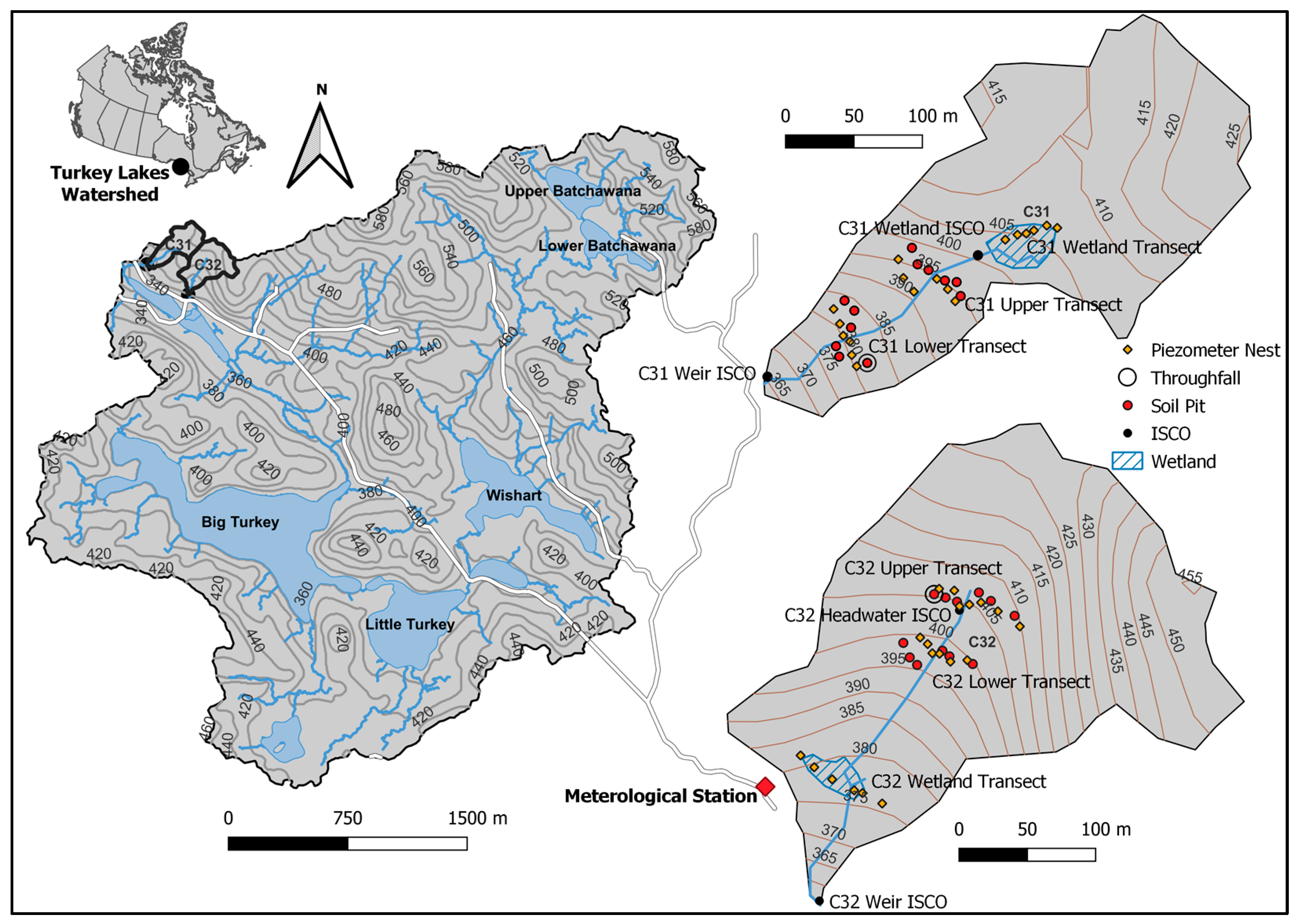
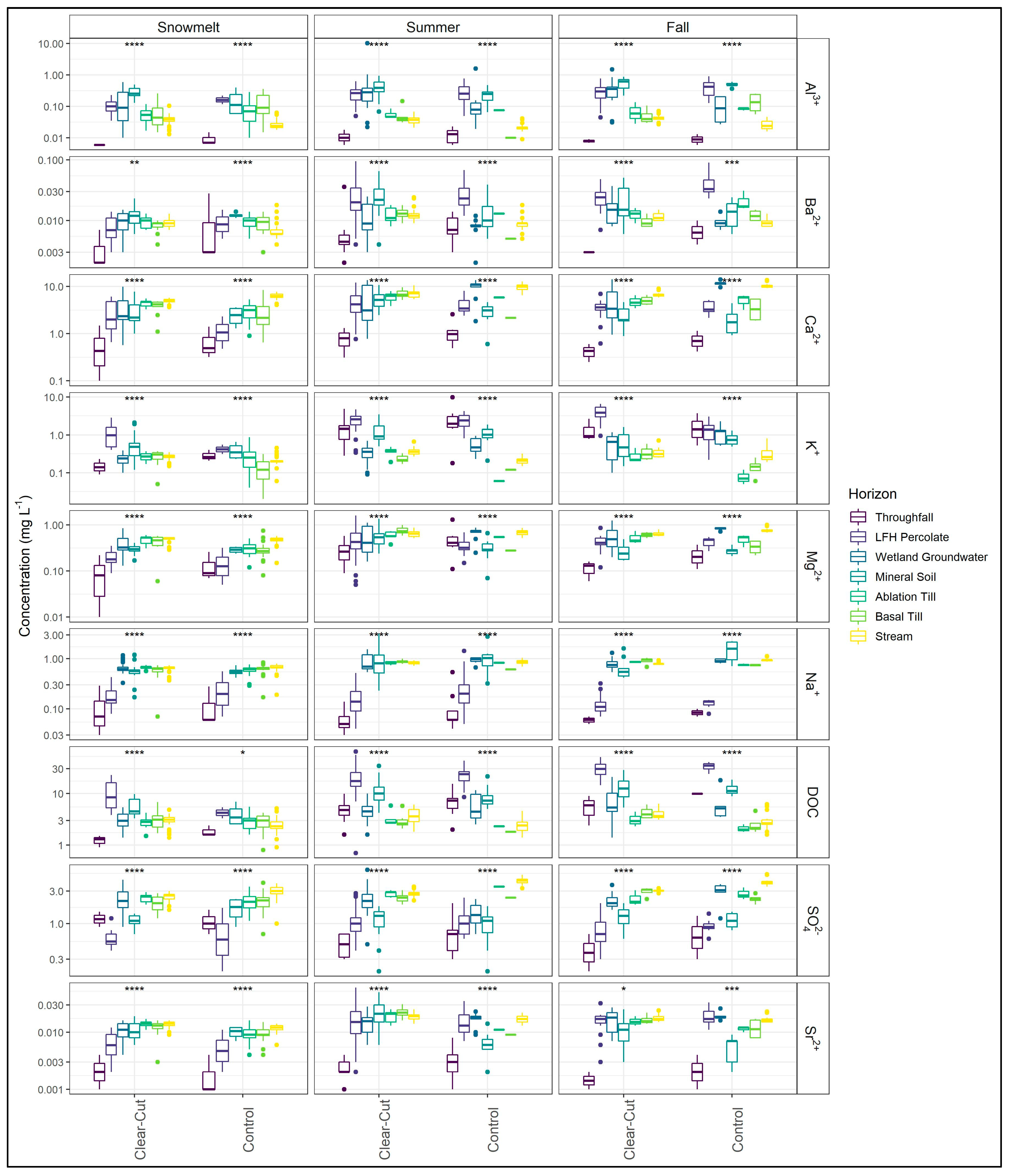
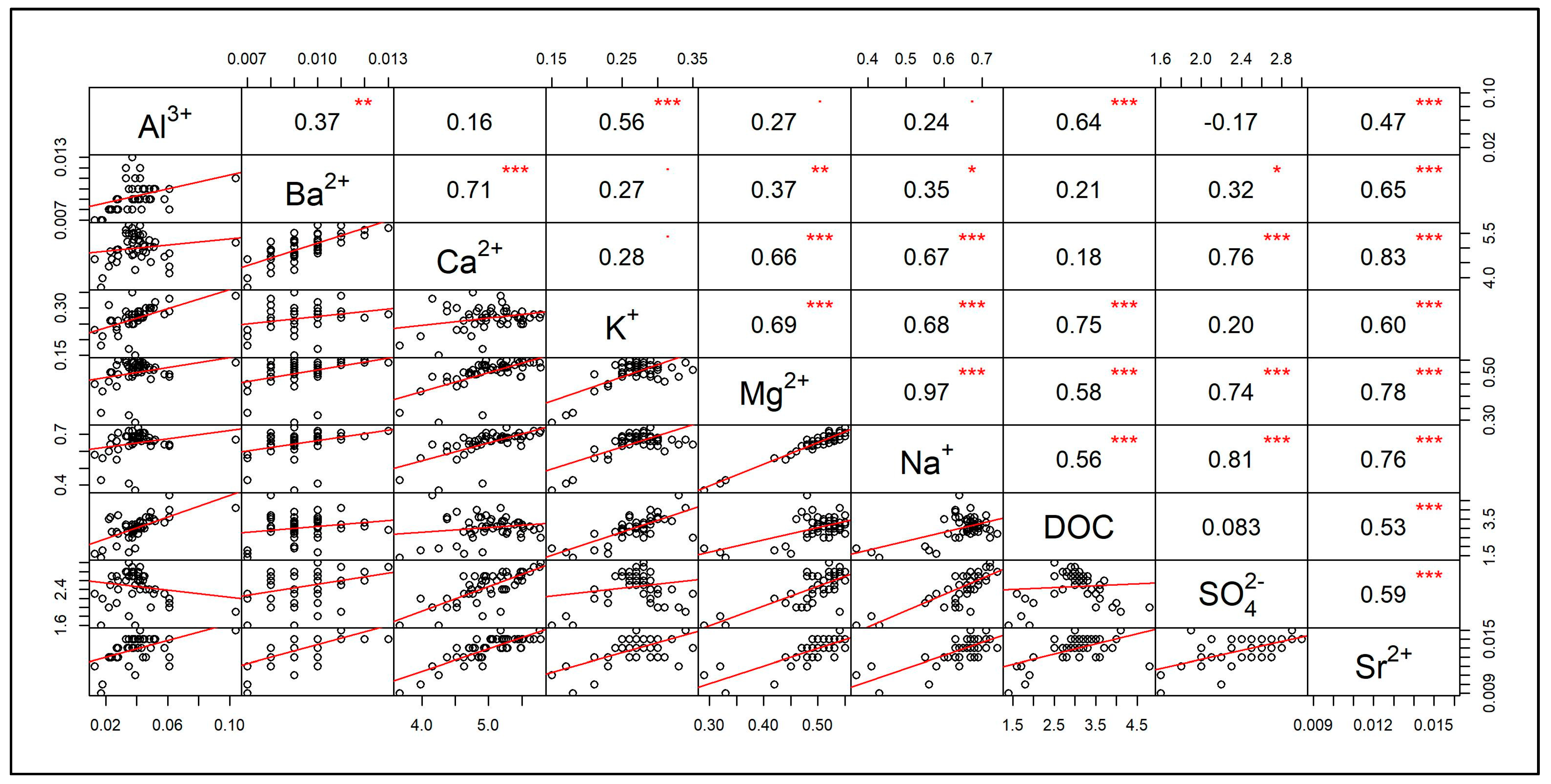
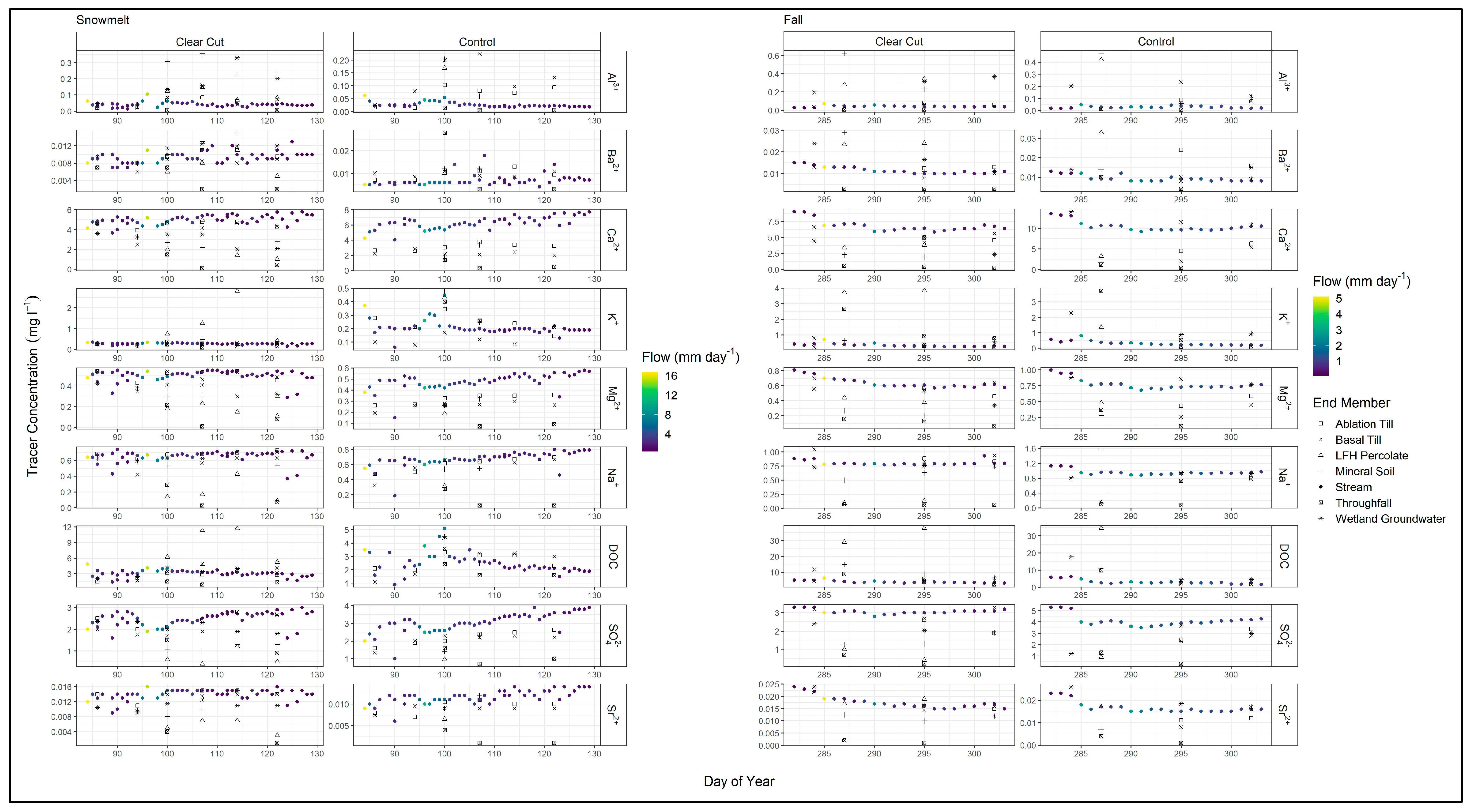
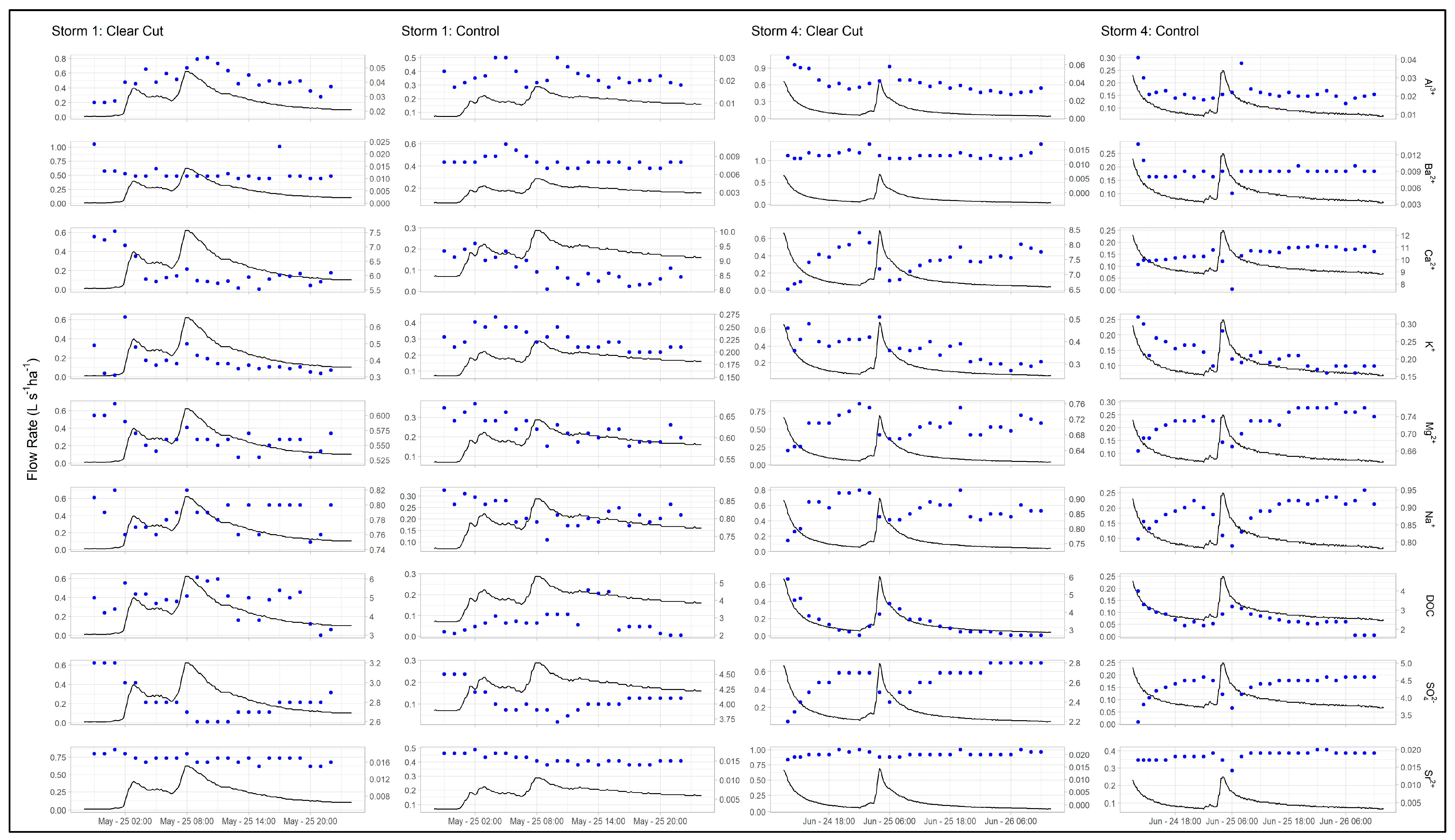

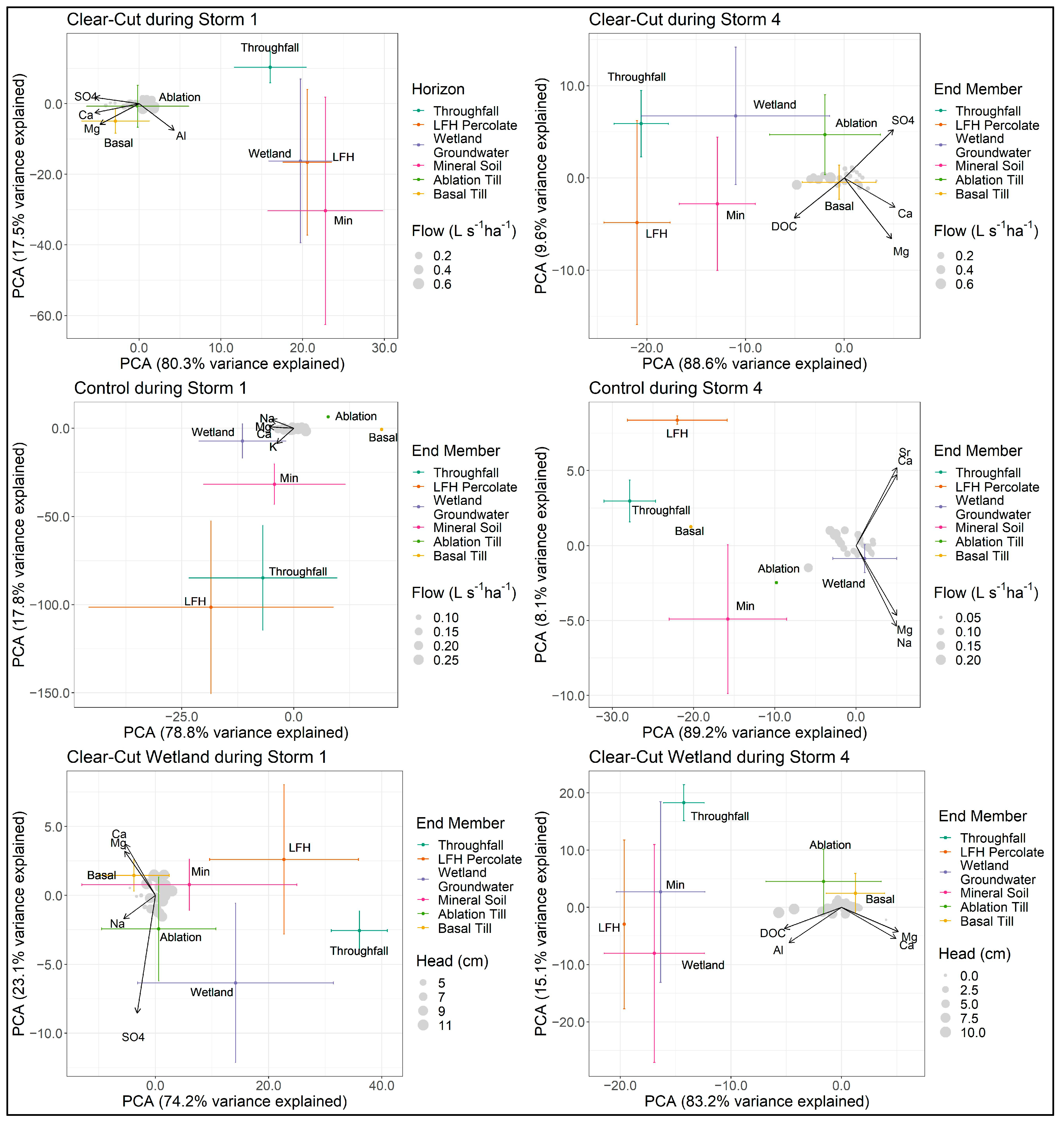

| Parameter | Snowmelt | Fall |
|---|---|---|
| Precipitation Depth (mm) | 117.5 | 97.9 |
| 2-Day Antecedent Precipitation (mm) | 23.0 | 10.3 |
| 7-Day Antecedent Precipitation (mm) | 24.3 | 25.6 |
| 14-Day Antecedent Precipitation (mm) | 53.5 | 39.5 |
| Peak Daily Precipitation (mm day−1) | 17.8 | 27.5 |
| Total Stream Flow (mm) | Clear-Cut: 140.1; Control: 151.6 | Clear-Cut: 18.5; Control: 27.4 |
| Peak Daily Runoff (mm day−1) | Clear-Cut: 16.6; Control: 16.6 | Clear-Cut: 5.1; Control: 2.7 |
| Stream Yield (%) | Clear-Cut: 119.2; Control: 130.3 | Clear-Cut: 18.9; Control: 28.0 |
| Location | Number of Zero-Flow Days * |
|---|---|
| Clear-Cut | 48 |
| Control | 0 |
| Clear-Cut Wetland | 65 |
| Control Initiation Point | 124 |
| Parameter | Storm 1 | Storm 4 |
|---|---|---|
| Precipitation Depth (mm) | 25.4 | 14.1 |
| 2-Day Antecedent Precipitation (mm) | 25.7 | 14.1 |
| 7-Day Antecedent Precipitation (mm) | 26.0 | 22.2 |
| 14-Day Antecedent Precipitation (mm) | 41.8 | 43.9 |
| Peak Instantaneous Precipitation Rate (mm 10 min−1) | 3.4 | 2.4 |
| Total Stream Flow (mm) | Clear-Cut: 2.1; Control: 1.7 | Clear-Cut: 2.8; Control: 1.9 |
| Peak Instantaneous Runoff Rate (L s−1 ha−1) | Clear-Cut: 0.6; Control: 0.3 | Clear-Cut: 0.7; Control: 0.2 |
| Stream Yield (%) | Clear-Cut: 8.2; Control: 6.7 | Clear-Cut: 19.5; Control: 13.6 |
| Catchment | End Member | Snowmelt | Summer Storms | Summer | Fall |
|---|---|---|---|---|---|
| Clear-Cut | Throughfall | 3 | 4 | 6 | 3 |
| LFH Percolate | 10 | 17 | 35 | 15 | |
| Wetland Groundwater | 34 | 14 | 16 | 13 | |
| Mineral Soil | 17 | 10 | 11 | 9 | |
| Ablation Till | 15 | 3 | 2 | 3 | |
| Basal Till | 12 | 4 | 4 | 4 | |
| Control | Throughfall | 3 | 3 | 6 | 2 |
| LFH Percolate | 2 | 6 | 19 | 7 | |
| Wetland Groundwater | 0 | 3 | 8 | 5 | |
| Mineral Soil | 4 | 3 | 8 | 5 | |
| Ablation Till | 33 | 0 | 1 | 3 | |
| Basal Till | 24 | 0 | 1 | 4 |
| Location | Flow Condition | Tracer Selection | Al3+ | Ba2+ | Ca2+ | K+ | Mg2+ | Na− | DOC | SO42− | Sr2+ |
|---|---|---|---|---|---|---|---|---|---|---|---|
| Clear-Cut | Snowmelt | Passed Tracer Selection | ✔ | ✔ | ✔ | ✔ | ✔ | ✔ | ✔ | ✔ | ✔ |
| Used in EMMA Model | ✔ | ✔ | ✔ | ✔ | |||||||
| Storm 1 | Passed Tracer Selection | ✔ | ✔ | ✔ | ✔ | ✔ | ✔ | ✔ | ✔ | ||
| Used in EMMA Model | ✔ | ✔ | ✔ | ✔ | ✔ | ||||||
| Storm 4 | Passed Tracer Selection | ✔ | ✔ | ✔ | ✔ | ✔ | ✔ | ✔ | ✔ | ✔ | |
| Used in EMMA Model | ✔ | ✔ | ✔ | ✔ | ✔ | ||||||
| Fall | Passed Tracer Selection | ✔ | ✔ | ✔ | ✔ | ✔ | ✔ | ✔ | ✔ | ✔ | |
| Used in EMMA Model | ✔ | ✔ | ✔ | ✔ | ✔ | ||||||
| Control | Snowmelt | Passed Tracer Selection | ✔ | ✔ | ✔ | ✔ | ✔ | ✔ | ✔ | ✔ | |
| Used in EMMA Model | ✔ | ✔ | ✔ | ✔ | |||||||
| Storm 1 | Passed Tracer Selection | ✔ | ✔ | ✔ | ✔ | ✔ | ✔ | ✔ | |||
| Used in EMMA Model | ✔ | ✔ | ✔ | ✔ | |||||||
| Storm 4 | Passed Tracer Selection | ✔ | ✔ | ✔ | ✔ | ✔ | ✔ | ✔ | ✔ | ✔ | |
| Used in EMMA Model | ✔ | ✔ | ✔ | ✔ | |||||||
| Fall | Passed Tracer Selection | ✔ | ✔ | ✔ | ✔ | ✔ | ✔ | ✔ | ✔ | ✔ | |
| Used in EMMA Model | ✔ | ✔ | ✔ | ✔ | |||||||
| Clear-Cut Wetland | Snowmelt | Passed Tracer Selection | ✔ | ✔ | ✔ | ✔ | ✔ | ✔ | ✔ | ✔ | |
| Used in EMMA Model | ✔ | ✔ | ✔ | ✔ | |||||||
| Storm 1 | Passed Tracer Selection | ✔ | ✔ | ✔ | ✔ | ✔ | ✔ | ✔ | ✔ | ||
| Used in EMMA Model | ✔ | ✔ | ✔ | ✔ | ✔ | ||||||
| Storm 4 | Passed Tracer Selection | ✔ | ✔ | ✔ | ✔ | ✔ | ✔ | ✔ | ✔ | ||
| Used in EMMA Model | ✔ | ✔ | ✔ | ✔ | ✔ | ||||||
| Fall | Passed Tracer Selection | ✔ | ✔ | ✔ | ✔ | ✔ | ✔ | ✔ | ✔ | ✔ | |
| Used in EMMA Model | ✔ | ✔ | ✔ | ✔ |
Disclaimer/Publisher’s Note: The statements, opinions and data contained in all publications are solely those of the individual author(s) and contributor(s) and not of MDPI and/or the editor(s). MDPI and/or the editor(s) disclaim responsibility for any injury to people or property resulting from any ideas, methods, instructions or products referred to in the content. |
© 2023 by the authors. Licensee MDPI, Basel, Switzerland. This article is an open access article distributed under the terms and conditions of the Creative Commons Attribution (CC BY) license (https://creativecommons.org/licenses/by/4.0/).
Share and Cite
Fines, R.W.; Stone, M.; Webster, K.L.; Leach, J.A.; Buttle, J.M.; Emelko, M.B.; Collins, A.L. Evaluation of Legacy Forest Harvesting Impacts on Dominant Stream Water Sources and Implications for Water Quality Using End Member Mixing Analysis. Water 2023, 15, 2825. https://doi.org/10.3390/w15152825
Fines RW, Stone M, Webster KL, Leach JA, Buttle JM, Emelko MB, Collins AL. Evaluation of Legacy Forest Harvesting Impacts on Dominant Stream Water Sources and Implications for Water Quality Using End Member Mixing Analysis. Water. 2023; 15(15):2825. https://doi.org/10.3390/w15152825
Chicago/Turabian StyleFines, Robert W., Micheal Stone, Kara L. Webster, Jason A. Leach, James M. Buttle, Monica B. Emelko, and Adrian L. Collins. 2023. "Evaluation of Legacy Forest Harvesting Impacts on Dominant Stream Water Sources and Implications for Water Quality Using End Member Mixing Analysis" Water 15, no. 15: 2825. https://doi.org/10.3390/w15152825
APA StyleFines, R. W., Stone, M., Webster, K. L., Leach, J. A., Buttle, J. M., Emelko, M. B., & Collins, A. L. (2023). Evaluation of Legacy Forest Harvesting Impacts on Dominant Stream Water Sources and Implications for Water Quality Using End Member Mixing Analysis. Water, 15(15), 2825. https://doi.org/10.3390/w15152825








